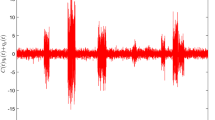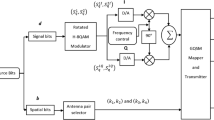Abstract
This paper presents some closed-form bit error probability expressions for coherent demodulation of both Gray coded and differentially decoded Gray coded QAM modulations in nonfading and frequency nonselective Rayleigh fading channels. These results demonstrate that as QAM constellation sizes get larger the BEP degradation due to differential encoding and decoding becomes negligible.
Similar content being viewed by others
References
T. Noguchi, Y. Daido, and J. A. Nossek, Modulation techniques for microwave digital radio,IEEE Communications Magazine, pp. 21–30, October 1986.
J. K. Cavers, An analysis of pilot symbol assisted QPSK for digital mobile communications,IEEE Global Telecommunications Conference, San Diego, pp. 507A.3.1–6, 1990.
S. Sampei and T. Sunaga, Rayleigh fading compensation QAM in land mobile radio communications,IEEE Transactions on Vehicular Technology, Vol. VT-42, pp. 137–147, 1993.
M. P. Fitz, Further results in the unified analysis of digital communication systems,IEEE Transactions on Communications, Vol. COM-40, pp. 521–532, 1992.
J. G. Proakis,Digital Communications, McGraw-Hill, New York, 1989.
J. Spilker,Digital Communications by Satellite, Prentice-Hall, Englewood Cliffs, NJ, 1977.
M. L. Moher and J. H. Lodge, TCMP—a modulation and coding scheme for Rician fading channels,IEEE Journal of Selected Areas in Communication, Vol. SAC-7, pp. 1347–1355, 1989.
A. Aghamohammadi and H. Meyr, On the error probability of linearly modulated signals on Rayleigh frequency-flat fading channels,IEEE Transactions on Communications, Vol. COM-38, pp. 1966–1970, 1990.
S. Stein, Unified analysis of certain coherent and noncoherent binary communication systems,IEEE Transactions on Information Theory, Vol. IT-10, pp. 43–51, 1964.
J. K. Cavers, An analysis of pilot symbol assisted modulation for Rayleigh faded channels,IEEE Transactions on Vehicular Technology, Vol. VT-40, pp. 686–693, 1991.
M. Abramowitz and I. E. Stegun (eds).Handbook of Mathematical Functions, U.S. Department of Commerce, Washington, DC, 1972.
M. P. Fitz, A dual-tone reference digital demodulator for mobile digital communications,IEEE Transactions on Vehicular Technology, Vol. VT-42, pp. 156–165, 1993.
Author information
Authors and Affiliations
Rights and permissions
About this article
Cite this article
Fitz, M.P., Seymour, J.P. On the bit error probability of QAM modulation. Int J Wireless Inf Networks 1, 131–139 (1994). https://doi.org/10.1007/BF02106515
Issue Date:
DOI: https://doi.org/10.1007/BF02106515




